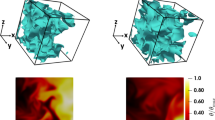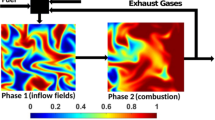Abstract
Three-dimensional Direct Numerical Simulation (DNS) data of methane-air MILD combustion is analysed to study the behaviour of MILD reaction zones and to identify a suitable modelling paradigm for MILD combustion. The combustion kinetics in the DNS was modelled using a skeletal mechanism including non-unity Lewis number effects. The reaction zones under MILD conditions are highly convoluted and contorted resulting in their frequent interactions. This leads to combustion occurring over a large portion of the computational volume and giving an appearance of distributed combustion. Three paradigms, standard flamelets, mild flame elements (MIFEs) and PSR, along with a presumed PDF model are explored to estimate the mean and filtered reaction rate in MILD combustion. A beta function is used to estimate the presumed PDF shape. The variations of species mass fractions and reaction rate with temperature computed using these models are compared to the DNS results. The PSR-based model is found to be appropriate, since the conditional averages obtained from the DNS agree well with those obtained using the PSR model. The flamelets model with MIFEs gives only a qualitative agreement because it does not include the effects of reaction zone interactions.









Similar content being viewed by others
References
Aminian, J., Galletti, C., Shahhosseini, S., Tognotti, L.: Key modeling issues in prediction of minor species in diluted-preheated combustion conditions. Appl. Thermal Eng. 31, 3287–3300 (2011)
Buschmann, A., Dinkelacker, F., Schäfer, T., Wolfrum, J.: Measurement of the instantaneous detailed flame structure in turbulent premixed combustion. Proc. Combust. Inst. 26, 437–445 (1996)
Cant, R.S.: SENGA2 User Guide. In: Technical Report CUED/A-THERMO/TR67. Cambridge University Engineering Department, Cambridge (2012)
Cavaliere, A., de Joannon, M.: Mild combustion. Progr. Energy Combust. Sci. 30, 329–366 (2004)
Chen, J.H., Echekki, T., Kollmann, W.: The mechanism of two-dimensional pocket formation in lean premixed methane-air flames with implications to turbulent combustion. Combust. Flame 116, 15–48 (1999)
Chen, Y.C., Peters, N., Schneemann, G.A., Wruck, N., Renz, U., Mansour, M.S.: The detailed flame structure of highly stretched turbulent premixed methane-air flames. Combust. Flame 107, 223–244 (1996)
Christo, F.C., Dally, B.B.: Modelling turbulent reacting jets issuing into a hot and diluted coflow. Combust. Flame 142, 117–129 (2005)
Coelho, P.J., Peters, N.: Numerical simulation of a mild combustion burner. Combust. Flame 124, 503–518 (2001)
COSILAB: The Combustion Simulation Laboratory Version 2.0.8. Rotexo-Softpredict-Cosilab GmbH & Co. KG, Germany (2007)
Dally, B.B., Riesmeier, E., Peters, N.: Effect of fuel mixture on moderate and intense low oxygen dilution combustion. Combust. Flame 137, 418–431 (2004)
Dunstan, T.D., Swaminathan, N., Bray, K.N.C., Kingsbury, N.G.: The effects of non-unity Lewis numbers on turbulent premixed flame interactions in a twin V-flame configuration. Combust. Sci. Technol. 185(6), 874–897 (2013a)
Dunstan, T.D., Swaminathan, N., Bray, K.N.C., Kingsbury, N.G.: Flame interactions in turbulent premixed twin V-flames. Combust. Sci. Technol. 185(1), 134–159 (2013b)
Duwig, C., Li, B., Aldén, M.: High resolution imaging of flameless and distributed turbulent combustion. Combust. Flame 159, 306–316 (2012)
Duwig, C., Stankovic, D., Fuchs, L., Li, G., Gutmark, E.: Experimental and numerical study of flameless combustion in a model gas turbine combustor. Combust. Sci. Technol. 180(2), 279–295 (2008)
Ertesvag, I.S., Magnussen, B.F.: A numerical study of a bluff-body stabilized diffusion flame. part 1. influence of turbulence modeling and boundary conditions. Combust. Sci. Technol. 119(1–6), 171–190 (1996a)
Ertesvag, I.S., Magnussen, B.F.: A numerical study of a bluff-body stabilized diffusion flame. Part 2. Influence of combustion modeling and finite-rate chemistry. Combust. Sci. Technol. 119(1–6), 191–217 (1996b)
Eswaran, V., Pope, S.B.: Direct numerical simulations of the turbulent mixing of a passive scalar. Phys. Fluids 31(3), 506–520 (1987)
Galletti, C., Parente, A., Tognotti, L.: Numerical and experimental investigation of a mild combustion burner. Combust. Flame 151, 649–664 (2007)
Hayashi, S., Mizobuchi, Y.: Utilization of hot burnt gas for better control of combustion and emissions. In: Swaminathan, N., Bray, K.N.C. (eds.) Turbulent Premixed Flames, pp. 365–378. Cambridge University Press, Cambridge (2011)
Ihme, M., See, Y.C.: Les flamelet modeling of a three-stream mild combustor: analysis of flame sensitivity to scalar inflow conditions. Proc. Combust. Inst. 33, 1309–1317 (2012)
Jenkins, K.W., Cant, R.S.: DNS of turbulent flame kernels. In: Knight & Sakell (eds.) Proc. Second AFOSR Conf. on DNS and LES. Rutgers University, Kluwer Academic Publishers, New Brunswick, pp. 192–202. (1999)
de Joannon, M., Saponaro, A., Cavaliere, A.: Zero-dimensional analysis of diluted oxidation of methane in rich conditions. Proc. Combust. Inst. 28, 1639–1646 (2000)
Katsuki, M., Hasegawa, T.: The science and technology of combustion in highly preheated air. Proc. Combust. Inst. 27, 3135–3146 (1998)
Krishnamurthy, N., Paul, P.J., Blasiak, W.: Studies on low-intensity oxy-fuel burner. Proc. Combust. Inst. 32, 3139–3146 (2009)
Li, P., Mi, J.: Influence of inlet dilution of reactants on premixed combustion in a recuperative furnace. Flow Turbulence Combust. 33, 1599–1607 (2011). doi:10.1007/s10494-011-9348-x
Magnussen, B.F.: On the structure of turbulence and a generalized eddy dissipation concept for chemical reaction in turbulent flow. In: 19th American Institute of Aeronautics and Astronautics Aerospace Science Meeting, pp. 1–6 (1981)
Medwell, P.R., Kalt, P.A.M., Dally, B.B.: Simultaneous imaging of OH, formaldehyde, and temperature of turbulent nonpremixed jet flames in a heated and diluted coflow. Combust. Flame 148, 48–61 (2007)
Minamoto, Y.: Physical aspects and modelling of turbulent MILD combustion. PhD thesis, Department of Engineering, University of Cambridge, Cambridge. (2013)
Minamoto, Y., Dunstan, T.D., Swaminathan, N., Cant, R.S.: DNS of EGR-type turbulent flame in MILD condition. Proc. Combust. Inst. 34, 3231–3238 (2013a)
Minamoto, Y., Swaminathan, N.: Scalar gradient behaviour in MILD combustion. Combust. Flame 161, 1063–1075 (2014). doi:10.1016/j.combustflame.2013.10.005
Minamoto, Y., Swaminathan, N., Cant, R. S., Leung, T.: Morphology of reaction zones in mild and premixed combustion. Combust. Flame (2013b) (submitted)
Oldenhof, E., Tummers, M.J., van Veen, E.H., Roekaerts, D.J.E.M.: Role of entrainment in the stabilisation of jet-in-hot-coflow flames. Combust. Flame 158, 1553–1563 (2011)
Orsino, S., Webber, R., Bollettini, U.: Numerical simulation of combustion of natural gas with high-temperature air. Comb. Sci. Technol. 170(1), 1–34 (2001)
Özdemir, Í.B., Peters, N.: Characteristics of the reaction zone in a combustor operating at MILD combustion. Exp. Fluids 30, 683–695 (2001)
Parente, A., Galletti, C., Tognotti, L.: A simplified approach for predicting NO formation in MILD combustion of \(\text{ CH }_{4}-{\text{ H }}_{2}\) mixtures. Proc. Combust. Inst. 33, 3343–3350 (2011)
Peters, N.: Turbulent Combustion. Cambridge University Press, Cambridge (2000)
Pfadler, S., Leipertz, A., Dinkelacker, F.: Systematic experiments on turbulent premixed Bunsen flame including turbulent flux measurement. Combust. Flame 152, 616–631 (2008)
Plessing, T., Peters, T., Wünning, J.G.: Laseroptical investigation of highly preheated combustion with strong exhaust gas recirculation. Proc. Combust. Inst. 27, 3197–3204 (1998)
Poinsot, T., Lele, S.: Boundary conditions for direct simulations of compressible viscos flows. J. Comput. Phys. 101, 104–129 (1992)
Rogallo, R.S.: Numerical experiments in homogeneous turbulence. NASA TM, p. 81315 (1981)
Smooke, M.D., Giovangigli, V.: Formulation of the Premixed and Nonpremixed Test Problems. In: Smooke, M.D. (ed.) Reduced Kinetic Mechanisms and Asymptotic Approximations for Methane-Air Flames, vol. 384, pp. 1–28. Springer, New York (1991)
Suzukawa, Y., Sugiyama, S., Hino, Y., Ishioka, M., Mori, I.: Heat transfer improvement and NOx reduction by highly preheated air combustion. Energy Convers. Manag 38(10–13), 1061–1071 (1997)
Swaminathan, N., Bilger, R.W., Cuenot, B.: Relationship between turbulent scalar flux and conditional dilatation in premixed flames with complex chemistry. Combust. Flame 126, 1764–1779 (2001)
Trouvé, A., Poinsot, T.: The evolution equation for the flame surface density in turbulent premixed combustion. J. Fluid Mech. 278, 1–31 (1994)
Weber, R., Orsino, S., Lallemant, N., Verlaan, A.: Combustion of natural gas with high-temperature air and large quantities of flue gas. Proc. Combust. Inst. 28, 1315–1321 (2000)
Wünning, J.A., Wünning, J.G.: Flameless oxidation to reduce thermal NO-formation. Prog. Energy Combust. Sci. 23, 81–94 (1997)
Acknowledgments
YM acknowledges the financial support of Nippon Keidanren and Cambridge Overseas Trust. EPSRC support is acknowledged by NS. This work made use of the facilities of HECToR, the UK’s national high-performance computing service, which is provided by UoE HPCx Ltd at the University of Edinburgh, Cray Inc and NAG Ltd, and funded by the Office of Science and Technology through EPSRCs High End Computing Programme.
Author information
Authors and Affiliations
Corresponding author
Rights and permissions
About this article
Cite this article
Minamoto, Y., Swaminathan, N. Modelling paradigms for MILD combustion. Int J Adv Eng Sci Appl Math 6, 65–75 (2014). https://doi.org/10.1007/s12572-014-0106-x
Published:
Issue Date:
DOI: https://doi.org/10.1007/s12572-014-0106-x




